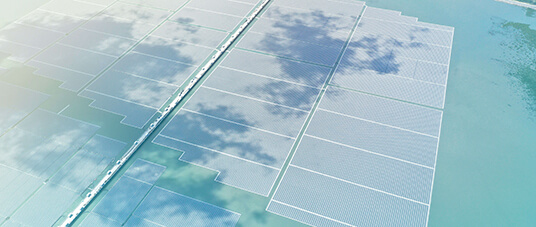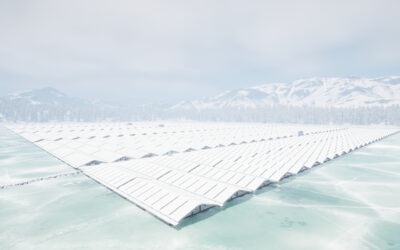The challenges of cleaning floating solar panels
One of the main challenges in maintaining a floating solar power plant is cleaning the solar panels, a task that is essential to ensure their optimum performance. Floating solar panels are exposed to various environmental fouling factors, including bird droppings, limescale deposits, algae and organic residues from the water, which can accumulate in large quantities on their surface. These elements reduce the panels’ ability to capture sunlight, thus diminishing their energy yield. In addition, access to the panels for cleaning is sometimes complex due to their position on floating structures, requiring adapted equipment and strict precautions to ensure the safety of technicians operating on the floating solar power plant. The choice of products used for cleaning must also be carefully considered and analyzed to preserve water quality and the integrity of the surrounding aquatic ecosystem. Rigorous maintenance is therefore essential to ensure the durability and profitability of floating solar power plants.
What are the solutions for cleaning floating solar panels?
To meet the challenges posed by floating solar panel fouling, several cleaning methods have been developed to ensure their effectiveness, while taking into account the specific constraints of these installations.
- Manual solutions, such as the use of brushes and water jets, remain commonplace, although they require human resources and time. .
- Automated systems, such as cleaning robots specially designed to operate on floating platforms, are also beginning to be deployed.
These robots are equipped with soft brushes or demineralized water jets, enabling effective cleaning without damaging panel surfaces or requiring the use of chemicals.


Challenges and Adaptations of Cleaning Robots for Large Floating Solar Panels
Increasing size of floating solar panels limits use of cleaning robots
In recent years, the photovoltaic industry has seen a significant increase in module size. Ciel & Terre, in line with this trend, has adapted its floats and FPV power plant designs to meet these new solar panel dimensions.
However, this evolution has introduced additional challenges for automated cleaning, particularly with the use of robots. The main obstacle lies in the transition from one module to another. When a robot, which represents a significant mass, is positioned on the edge of a PV module, the latter tends to tilt. This creates a step that is difficult to overcome in order to access the next module, and therefore hinders the robot’s progress on the power plant without the intervention of a technician.
How can these cleaning robots be adapted to large PV modules?
To remedy this problem, the Ciel & Terre EMEA maintenance team is working on adapting robots available on the market. The aim is to solve the problem of tilting PV modules and inter-module crossing.
One potential solution would be for the robot to be able to lean on the next PV module, thus avoiding tilting. This would enable the robot to move along a series of PV modules as if it were on a flat surface. To achieve this, telescopic arms, considered as extensions of the robot, coupled with skis or wheels, could be integrated. These devices would prevent damage to the next module, while providing sufficient support to prevent tipping.
This innovative approach could revolutionize the cleaning of floating photovoltaic modules, ensuring efficient, damage-free maintenance, even for large-scale installations.
& Raphael, O&M









